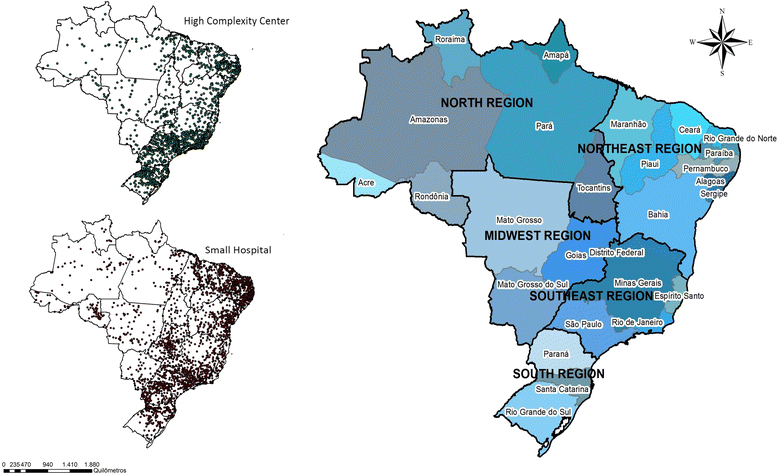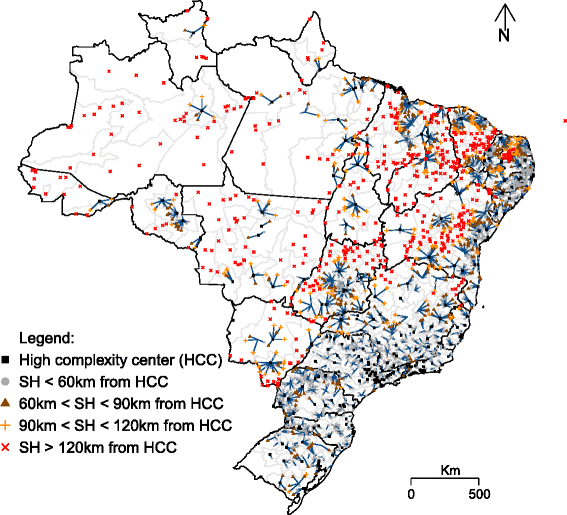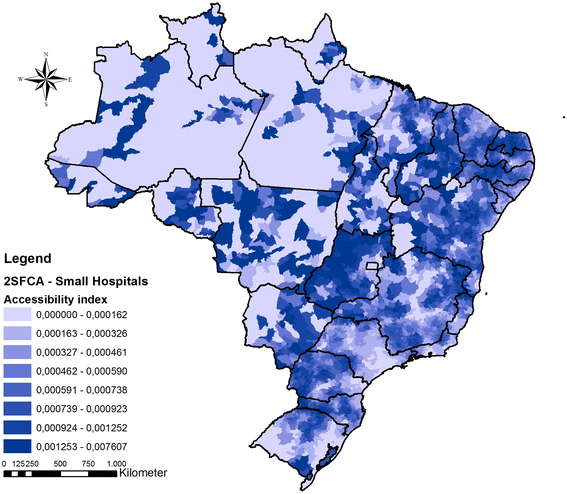Addressing geographic access barriers to emergency care services: a national ecologic study of hospitals in Brazil
- PMID: 28830521
- PMCID: PMC5568346
- DOI: 10.1186/s12939-017-0645-4
Addressing geographic access barriers to emergency care services: a national ecologic study of hospitals in Brazil
Abstract
Background: Unequal distribution of emergency care services is a critical barrier to be overcome to assure access to emergency and surgical care. Considering this context it was objective of the present work analyze geographic access barriers to emergency care services in Brazil. A secondary aim of the study is to define possible roles to be assumed by small hospitals in the Brazilian healthcare network to overcome geographic access challenges.
Methods: The present work can be classified as a cross-sectional ecological study. To carry out the present study, data of all 5843 Brazilian hospitals were categorized among high complexity centers and small hospitals. The geographical access barriers were identified through the use of two-step floating catchment area method. Once concluded the previous step an evaluation using the Getis-Ord-Gi method was performed to identify spatial clusters of municipalities with limited access to high complexity centers but well covered by well-equipped small hospitals.
Results: The analysis of accessibility index of high complexity centers highlighted large portions of the country with nearly zero hospital beds by inhabitant. In contrast, it was possible observe a group of 1595 municipalities with high accessibility to small hospitals, simultaneously with a low coverage of high complexity centers. Among the 1595 municipalities with good accessibility to small hospitals, 74% (1183) were covered by small hospitals with at least 60% of minimum emergency service requirements. The spatial clusters analysis aggregated 589 municipalities with high values related to minimum emergency service requirements. Small hospitals in these 589 cities could promote the equity in access to emergency services benefiting more than eight million people.
Conclusions: There is a spatial disequilibrium within the country with prominent gaps in the health care network for emergency services. Taking this challenge into consideration, small hospitals could be a possible solution and foster equity in access to emergency and surgical care. However more investments in are necessary to improve small hospitals capabilities to fill this gap.
Keywords: Emergency health services; Health care evaluation mechanisms; Health services accessibility; Hospitals; Low-volume hospitals; Rural hospitals; Spatial analysis; Spatial autocorrelation.
Conflict of interest statement
Ethics approval and consent to participate
The present study was carried out with ethical approval from the Committee on Ethics in Research (Comitê de Ética em Pesquisa) of the Federal University of Pelotas, number 546.012, (CAAE): 27,098,914.9.0000.5317.
Consent for publication
Not applicable.
Competing interests
The authors declare that they have no competing interests.
Publisher’s Note
Springer Nature remains neutral with regard to jurisdictional claims in published maps and institutional affiliations.
Figures






References
-
- Clancy CM. Acute care quality improves while barriers to access remain: AHRQ’s 2012 healthcare quality and disparities reports. Am J Med Qual. 2013;28:443–5. Available from: https://www.ncbi.nlm.nih.gov/pubmed/23880776. [cited 23 Dec 2016]. - PubMed
-
- Ensor T, Cooper S. Overcoming barriers to health service access: influencing the demand side. Health Policy Plan. 2004;19:69–79. Available from: https://www.ncbi.nlm.nih.gov/pubmed/?term=Overcoming+barriers+to+health+.... [cited 23 Dec 2016]. - PubMed
-
- Guagliardo MF. Spatial accessibility of primary care: concepts, methods and challenges. Int J Health Geogr. 2004;3:3. Available from: https://ij-healthgeographics.biomedcentral.com/articles/10.1186/1476-072.... - DOI - PMC - PubMed
MeSH terms
LinkOut - more resources
Full Text Sources
Other Literature Sources
Medical
Miscellaneous

